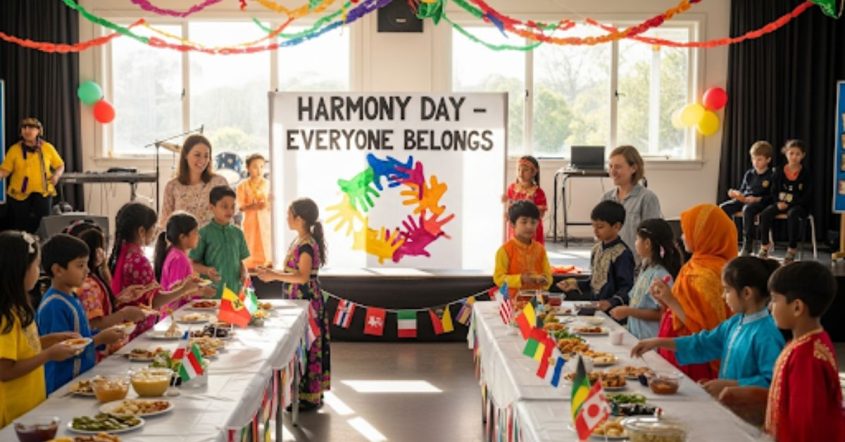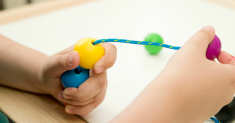Harmony Day is a special day celebrated every year on March 21 in Australia. It is a day that helps people understand the importance of accepting and respecting everyone, no matter their culture, background, or language. This day matches the United Nations’ International Day for the Elimination of Racial Discrimination. In schools, Harmony Day is especially meaningful. It gives students a chance to learn about other cultures and traditions in fun and educational ways. It teaches them that everyone belongs and that differences should be celebrated, not feared.
Historical Origins
Harmony Day began in 1999 under the Australian government. The idea was to create a day where people from all backgrounds could feel included and valued. The date, March 21, was chosen because it is also the UN’s day to remember the Sharpeville massacre in South Africa in 1960, where peaceful protesters against racial laws were killed. By linking Harmony Day to this international observance, Australia wanted to send a message that racism and discrimination have no place in society.
Although Harmony Day has a positive and friendly name, it has serious roots. It’s meant to remind us all that respect, kindness, and understanding are powerful tools for creating a peaceful society. Schools are the best place to start teaching these lessons to children so they can grow up to become caring, open-minded adults.
Why Schools Observe It
Schools are places where children from different backgrounds come together every day. Harmony Day is a great opportunity for teachers to talk about important values like inclusiveness, respect, and belonging. It’s also a day to recognize the many cultures that make up the school community.
When students take part in Harmony Day activities, they get a chance to learn about each other’s traditions, languages, and histories. This helps build friendships, break down stereotypes, and reduce bullying. It also teaches kids to be proud of who they are and to respect others who may look or live differently from them.
For younger children, Harmony Day introduces the idea that the world is made up of many different kinds of people. For older students, it opens up discussions about race, equality, and fairness. Through stories, group projects, and open conversations, Harmony Day becomes a safe space to ask questions and share personal experiences.
Key Themes & Messages for Students
The main message of Harmony Day is simple: “Everyone Belongs.” This slogan helps children understand that no matter where they come from, they are valued and accepted. Schools use this message in classroom decorations, activities, and speeches to create a warm and welcoming environment.
Another important symbol of Harmony Day is the color orange. Students and teachers are encouraged to wear orange on the day. This color represents social communication, meaningful conversations, and respect for different ideas. By wearing orange, everyone shows that they support diversity and kindness.
Harmony Day is also a chance to talk about fairness and standing up for others. Kids learn that it’s not just about celebrating culture one day a year, it’s about being kind every day. Students are encouraged to be brave, to speak up if someone is being treated unfairly, and to include others in games and groups.
Common School Activities
Schools all over Australia celebrate Harmony Day in fun and creative ways. These activities not only entertain but also educate students about the beauty of multiculturalism.
1. Classroom Crafts
Teachers often organize art projects that focus on themes of unity and diversity. For example:
- Handprint collages: Each student creates a handprint, and all are combined into a mural.
- World flags art: Children draw or color flags from different countries.
- Cultural posters: Groups make posters about different countries or traditions.
2. Songs and Dances
Music and dance are great ways to celebrate culture. Schools may invite families to share songs or dances from their heritage. Some students perform traditional dances or play instruments, and the whole school may join in singing songs from around the world.
3. Multicultural Food Sharing
Food brings people together. On Harmony Day, schools may organize a multicultural lunch or food stall. Parents can send dishes from their cultural backgrounds, and students get to try new tastes and learn where the dishes come from.
4. Story Time and Book Reading
Teachers read stories that highlight themes like kindness, acceptance, and diversity. Books featuring characters from different cultures help children see the world from many perspectives.
5. Class Discussions and Writing Prompts
Teachers may lead discussions with questions like:
- What makes you feel included?
- What do you love about your culture?
- How can we help others feel welcome?
Students can also write short essays or draw pictures about what Harmony Day means to them.
6. Dress-Up Days
Some schools hold cultural dress-up days. Students are invited to wear traditional clothes from their culture or a country they have learned about. It’s a colorful and exciting way to learn about fashion and traditions from around the world.
7. Classroom Pledges
Students create a group pledge or promise to be kind, fair, and respectful to everyone. This pledge is displayed in the classroom as a daily reminder of what they learned on Harmony Day.
Why It Matters
Celebrating Harmony Day in schools matters because it helps children understand the world around them. We live in a global society, and learning how to respect others is a skill that children need as they grow.
By celebrating this day:
- Children become more accepting: They learn that differences in skin color, language, or customs are something to be proud of, not ashamed of.
- Bullying is reduced: Students who understand and accept others are less likely to bully or tease.
- Confidence grows: When children feel their culture is valued, they feel confident and proud.
- Friendships blossom: Children who might not have talked to each other before now have a reason to connect.
Also, when kids see teachers and parents celebrating Harmony Day, it sends a strong message that inclusion is important. They learn that kindness isn’t just talked about, it’s shown through action.
Addressing Criticisms Thoughtfully
While Harmony Day is a positive and joyful event, some people believe it doesn’t go far enough in teaching children about serious issues like racism. Critics say the original purpose of March 21, as the UN’s International Day for the Elimination of Racial Discrimination, can get lost in the fun of dress-ups and food.
Some teachers and groups suggest that while Harmony Day is great for promoting unity, schools should also talk honestly about racism, stereotypes, and historical injustice. They argue that children can handle these topics if they are taught in a careful and age-appropriate way.
Others believe Harmony Day should be renamed or reconnected more strongly with its international roots, to remind everyone that the fight against discrimination is not over. These suggestions don’t mean Harmony Day is bad. Instead, they remind us that celebration and education should go hand in hand.
By including lessons about fairness, justice, and equality, schools can make Harmony Day both joyful and meaningful. It can be a day to celebrate cultures and also to reflect on how we can make the world a better place.
Conclusion
In schools, Harmony Day is more than just a celebration. It’s a powerful tool for shaping the minds and hearts of the next generation. Through fun activities, thoughtful discussions, and shared experiences, children learn to respect, accept, and value one another.
Harmony Day teaches that everyone belongs. No matter where you’re from, what language you speak, or how you look, your presence matters. By celebrating this day, schools help build a culture of inclusion, kindness, and peace.
When children grow up understanding the beauty of diversity, they are more likely to become kind, thoughtful adults. And when schools lead the way in promoting harmony, they create a ripple effect that touches families, communities, and the whole country.
















